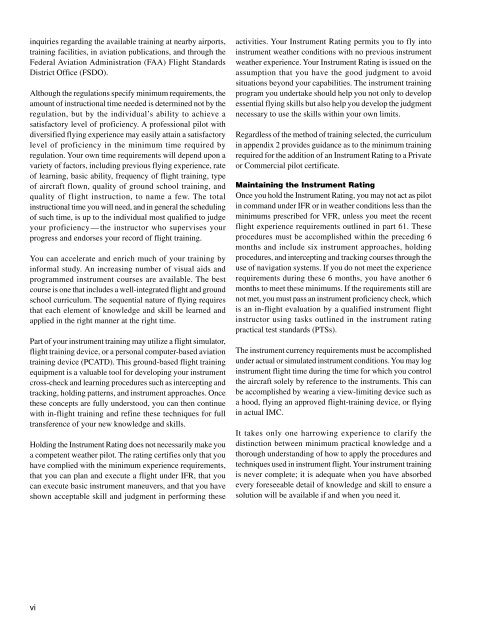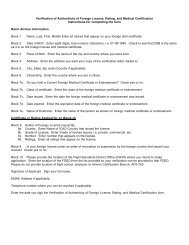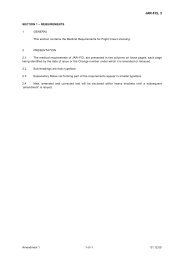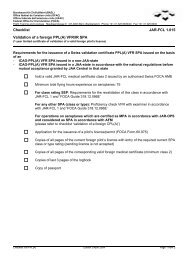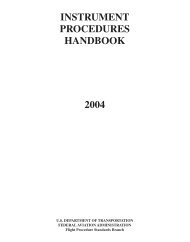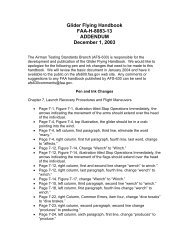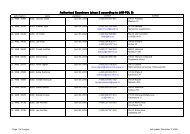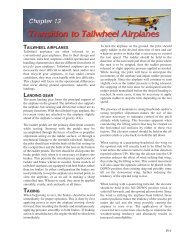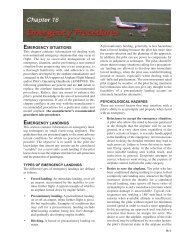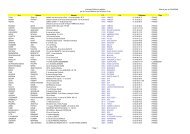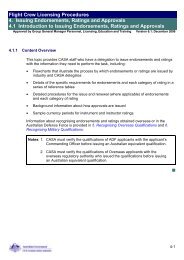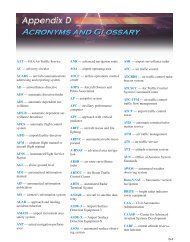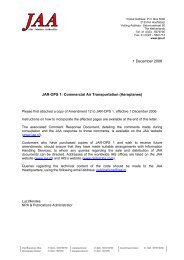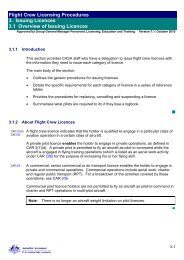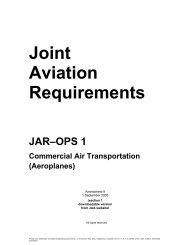IntroductionIs an <strong>Instrument</strong> Rating Necessary?The answer to this question depends entirely upon individualneeds. Pilots who fly in familiar uncongested areas, staycontinually alert to weather developments, and accept analternative to their original plan, may not need an <strong>Instrument</strong>Rating. However, some cross-country destinations may takea pilot to unfamiliar airports and/or through high activity areasin marginal visual or instrument meteorological conditions(IMC). Under these conditions, an <strong>Instrument</strong> Rating may bean alternative to rerouting, rescheduling, or canceling a flight.Many accidents are the result <strong>of</strong> pilots who lack the necessaryskills or equipment to fly in marginal visual meteorologicalconditions (VMC) or IMC conditions and attempt flightwithout outside references.Pilots originally flew aircraft strictly by sight, sound, and feelwhile comparing the aircraft’s attitude to the natural horizon.As aircraft performance increased, pilots required more inflightinformation to enhance the safe operation <strong>of</strong> theiraircraft. This information has ranged from a string tied to awing strut, to development <strong>of</strong> sophisticated electronic flightinformation systems (EFIS) and flight management systems(FMS). Interpretation <strong>of</strong> the instruments and aircraft controlhave advanced from the “one, two, three” or “needle, balland airspeed” system to the use <strong>of</strong> “attitude instrumentflying” techniques.Navigation began by using ground references with deadreckoning and has led to the development <strong>of</strong> electronicnavigation systems. These include the automatic directionfinder (ADF), very-high frequency omnidirectional range(VOR), distance measuring equipment (DME), tactical airnavigation (TACAN), long range navigation (LORAN),global positioning system (GPS), instrument landing system(ILS), microwave landing system (MLS), and inertialnavigation system (INS).Perhaps you want an <strong>Instrument</strong> Rating for the same basicreason you learned to fly in the first place— because you likeflying. Maintaining and extending your pr<strong>of</strong>iciency, once youhave the rating, means less reliance on chance and more onskill and knowledge. Earn the rating—not because you mightneed it sometime, but because it represents achievement andprovides training you will use continually and build upon aslong as you fly. But most importantly—it means greatersafety in flying.<strong>Instrument</strong> Rating RequirementsA Private or Commercial pilot who operates an aircraft usingan instrument flight rules (IFR) flight plan operates inconditions less than the minimums prescribed for visual flightrules (VFR), or in any flight in Class A airspace, must havean <strong>Instrument</strong> Rating and meet the appropriate currencyrequirements.You will need to carefully review the aeronautical knowledgeand experience requirements for the <strong>Instrument</strong> Rating asoutlined in Title 14 <strong>of</strong> the Code <strong>of</strong> Federal Regulations (14CFR) part 61. After completing the <strong>FAA</strong> Knowledge Testissued for the <strong>Instrument</strong> Rating, and all the experiencerequirements have been satisfied, you are eligible to take thepractical test. The regulations specify minimum total and pilotin command time requirements. This minimum applies to allapplicants—regardless <strong>of</strong> ability or previous aviationexperience.Training for the <strong>Instrument</strong> RatingA person who wishes to add the <strong>Instrument</strong> Rating to theirpilot certificate must first make commitments <strong>of</strong> time, money,and quality <strong>of</strong> training. There are many combinations <strong>of</strong>training methods available. Self-study alone may be adequatepreparation to pass the required <strong>FAA</strong> Knowledge Test for the<strong>Instrument</strong> Rating. Occasional periods <strong>of</strong> ground and flightinstruction may provide the skills necessary to pass therequired test. Or, individuals may choose a training facilitythat provides comprehensive aviation education and thetraining necessary to ensure the pilot will pass all the requiredtests and operate safely in the National Airspace System(NAS). The aeronautical knowledge may be administered byeducational institutions, aviation-oriented schools,correspondence courses, and appropriately-rated instructors.Each person must decide for themselves which trainingprogram best meets their needs and at the same time maintaina high quality <strong>of</strong> training. Interested persons should makev
inquiries regarding the available training at nearby airports,training facilities, in aviation publications, and through theFederal Aviation Administration (<strong>FAA</strong>) Flight StandardsDistrict Office (FSDO).Although the regulations specify minimum requirements, theamount <strong>of</strong> instructional time needed is determined not by theregulation, but by the individual’s ability to achieve asatisfactory level <strong>of</strong> pr<strong>of</strong>iciency. A pr<strong>of</strong>essional pilot withdiversified flying experience may easily attain a satisfactorylevel <strong>of</strong> pr<strong>of</strong>iciency in the minimum time required byregulation. Your own time requirements will depend upon avariety <strong>of</strong> factors, including previous flying experience, rate<strong>of</strong> learning, basic ability, frequency <strong>of</strong> flight training, type<strong>of</strong> aircraft flown, quality <strong>of</strong> ground school training, andquality <strong>of</strong> flight instruction, to name a few. The totalinstructional time you will need, and in general the scheduling<strong>of</strong> such time, is up to the individual most qualified to judgeyour pr<strong>of</strong>iciency—the instructor who supervises yourprogress and endorses your record <strong>of</strong> flight training.You can accelerate and enrich much <strong>of</strong> your training byinformal study. An increasing number <strong>of</strong> visual aids andprogrammed instrument courses are available. The bestcourse is one that includes a well-integrated flight and groundschool curriculum. The sequential nature <strong>of</strong> flying requiresthat each element <strong>of</strong> knowledge and skill be learned andapplied in the right manner at the right time.Part <strong>of</strong> your instrument training may utilize a flight simulator,flight training device, or a personal computer-based aviationtraining device (PCATD). This ground-based flight trainingequipment is a valuable tool for developing your instrumentcross-check and learning procedures such as intercepting andtracking, holding patterns, and instrument approaches. Oncethese concepts are fully understood, you can then continuewith in-flight training and refine these techniques for fulltransference <strong>of</strong> your new knowledge and skills.Holding the <strong>Instrument</strong> Rating does not necessarily make youa competent weather pilot. The rating certifies only that youhave complied with the minimum experience requirements,that you can plan and execute a flight under IFR, that youcan execute basic instrument maneuvers, and that you haveshown acceptable skill and judgment in performing theseactivities. Your <strong>Instrument</strong> Rating permits you to fly intoinstrument weather conditions with no previous instrumentweather experience. Your <strong>Instrument</strong> Rating is issued on theassumption that you have the good judgment to avoidsituations beyond your capabilities. The instrument trainingprogram you undertake should help you not only to developessential flying skills but also help you develop the judgmentnecessary to use the skills within your own limits.Regardless <strong>of</strong> the method <strong>of</strong> training selected, the curriculumin appendix 2 provides guidance as to the minimum trainingrequired for the addition <strong>of</strong> an <strong>Instrument</strong> Rating to a Privateor Commercial pilot certificate.Maintaining the <strong>Instrument</strong> RatingOnce you hold the <strong>Instrument</strong> Rating, you may not act as pilotin command under IFR or in weather conditions less than theminimums prescribed for VFR, unless you meet the recentflight experience requirements outlined in part 61. Theseprocedures must be accomplished within the preceding 6months and include six instrument approaches, holdingprocedures, and intercepting and tracking courses through theuse <strong>of</strong> navigation systems. If you do not meet the experiencerequirements during these 6 months, you have another 6months to meet these minimums. If the requirements still arenot met, you must pass an instrument pr<strong>of</strong>iciency check, whichis an in-flight evaluation by a qualified instrument flightinstructor using tasks outlined in the instrument ratingpractical test standards (PTSs).The instrument currency requirements must be accomplishedunder actual or simulated instrument conditions. You may loginstrument flight time during the time for which you controlthe aircraft solely by reference to the instruments. This canbe accomplished by wearing a view-limiting device such asa hood, flying an approved flight-training device, or flyingin actual IMC.It takes only one harrowing experience to clarify thedistinction between minimum practical knowledge and athorough understanding <strong>of</strong> how to apply the procedures andtechniques used in instrument flight. Your instrument trainingis never complete; it is adequate when you have absorbedevery foreseeable detail <strong>of</strong> knowledge and skill to ensure asolution will be available if and when you need it.vi
- Page 4: PrefaceThis Instrument Flying Handb
- Page 9 and 10: Chapter 3Flight Instruments .......
- Page 12 and 13: Chapter 10IFR Flight ..............
- Page 15 and 16: The only effective way to counter t
- Page 17 and 18: aircraft tends to lose altitude in
- Page 19 and 20: disoriented and the instructor pilo
- Page 21 and 22: 5. Utilize the visual descent point
- Page 23 and 24: antihistamines, blood pressure drug
- Page 25 and 26: Figure 1-7B illustrates the ADM pro
- Page 27 and 28: 1-14
- Page 29 and 30: Figure 2-1. Newton’s First Law of
- Page 31 and 32: altitude, you must lower the pitch
- Page 33 and 34: The force of the airflow striking t
- Page 35 and 36: speed is constant, increasing the b
- Page 37 and 38: The most hazardous aspect of struct
- Page 39 and 40: the fuselage or the vertical fin. T
- Page 41 and 42: A sensitive altimeter is one with a
- Page 43 and 44: Extreme differences between ambient
- Page 45 and 46: Mach NumberAs an aircraft approache
- Page 47 and 48: This is done to correct for deviati
- Page 49 and 50: To find the true course that is bei
- Page 51 and 52: Figure 3-21. A vertical card magnet
- Page 53 and 54: Gyroscopic SystemsFlight without re
- Page 55 and 56:
Figure 3-28. Twin-engine instrument
- Page 57 and 58:
Directional gyros are almost all ai
- Page 59 and 60:
The inclinometer, similar to the on
- Page 61 and 62:
After Engine Start1. When you turn
- Page 63 and 64:
Figure 4-1. Control/Performance cro
- Page 65 and 66:
Figure 4-2. Primary/Supporting cros
- Page 67 and 68:
This cross-checking method gives eq
- Page 69 and 70:
4-8
- Page 71 and 72:
Figure 5-1. Pitch attitude and airs
- Page 73 and 74:
Figure 5-7. Using the altimeter for
- Page 75 and 76:
Vertical Speed IndicatorThe vertica
- Page 77 and 78:
Figure 5-16. Instruments used for b
- Page 79 and 80:
airspeed constant, the airplane wil
- Page 81 and 82:
Figure 5-23. Straight-and-level fli
- Page 83 and 84:
You will have developed a high leve
- Page 85 and 86:
3. Faulty sequence in trim techniqu
- Page 87 and 88:
Figure 5-27. Stabilized climb at co
- Page 89 and 90:
EntryThe following method for enter
- Page 91 and 92:
Common Errors in Straight Climbs an
- Page 93 and 94:
Figure 5-34. Turn coordinator calib
- Page 95 and 96:
Figure 5-36. Steep left turn.Steep
- Page 97 and 98:
Climbing and Descending TurnsTo exe
- Page 99 and 100:
have a specific reason to turn the
- Page 101 and 102:
Figure 5-40. Unusual attitude—nos
- Page 103 and 104:
except as a last resort, as it usua
- Page 105 and 106:
Figure 5-43. 80/260 procedure turn
- Page 107 and 108:
Figure 6-1. In most situations, the
- Page 109 and 110:
Figure 6-2. The flight instruments
- Page 111 and 112:
lowered. A rapid change in airspeed
- Page 113 and 114:
Power Control During Straight-and-L
- Page 115 and 116:
Common Errors During Airspeed Chang
- Page 117 and 118:
Figure 6-10. Flight instrument indi
- Page 119 and 120:
To recover to straight-and-level fl
- Page 121 and 122:
Figure 6-12. Flight instrument indi
- Page 123 and 124:
Instrument TakeoffThe procedures an
- Page 125 and 126:
Sky WaveThe sky wave, at frequencie
- Page 127 and 128:
Function of ADFThe ADF can be used
- Page 129 and 130:
7-6330°WIND015°306912152118243027
- Page 131 and 132:
2. Positively identifying any malfu
- Page 133 and 134:
TO/FROM indicator. The TO/FROM indi
- Page 135 and 136:
Course interception is illustrated
- Page 137 and 138:
selection assures reception of azim
- Page 139 and 140:
Without an RMI, orientation is more
- Page 141 and 142:
2. MODE select switch used to selec
- Page 143 and 144:
The Aeronautical Information Manual
- Page 145 and 146:
Function of GPSGPS operation is bas
- Page 147 and 148:
To determine the aircraft position
- Page 149 and 150:
the FAWP. As sensitivity changes fr
- Page 151 and 152:
Figure 7-23. Instrument landing sys
- Page 153 and 154:
Marker BeaconsTwo VHF marker beacon
- Page 155 and 156:
Runway end identifier lights (REIL)
- Page 157 and 158:
Figure 7-29. Glide-slope receiver i
- Page 159 and 160:
Approach Azimuth StationThe approac
- Page 161 and 162:
to this target can be instantly det
- Page 163:
7-40


